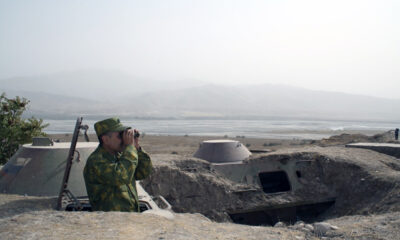Science & Technology
Satellite imagery shows Antarctic ice shelf crumbling faster than thought

Antarctica’s coastal glaciers are shedding icebergs more rapidly than nature can replenish the crumbling ice, doubling previous estimates of losses from the world’s largest ice sheet over the past 25 years, a satellite analysis showed on Wednesday.
The first-of-its-kind study, led by researchers at NASA’s Jet Propulsion Laboratory (JPL) near Los Angeles and published in the journal Nature, raises new concern about how fast climate change is weakening Antarctica’s floating ice shelves and accelerating the rise of global sea levels, Reuters reported.
The study’s key finding was that the net loss of Antarctic ice from coastal glacier chunks “calving” off into the ocean is nearly as great as the net amount of ice that scientists already knew was being lost due to thinning caused by the melting of ice shelves from below by warming seas.
Taken together, thinning and calving have reduced the mass of Antarctica’s ice shelves by 12 trillion tons since 1997, double the previous estimate, the analysis concluded.
The net loss of the continent’s ice sheet from calving alone in the past quarter-century spans nearly 37,000 sq km, an area almost the size of Switzerland, according to JPL scientist Chad Greene, the study’s lead author.
“Antarctica is crumbling at its edges,” Greene said in a NASA announcement of the findings. “And when ice shelves dwindle and weaken, the continent’s massive glaciers tend to speed up and increase the rate of global sea level rise.”
The consequences could be enormous. Antarctica holds 88% of the sea level potential of all the world’s ice, he said.
Ice shelves, permanent floating sheets of frozen freshwater attached to land, take thousands of years to form and act like buttresses holding back glaciers that would otherwise easily slide off into the ocean, causing seas to rise.
When ice shelves are stable, the long-term natural cycle of calving and re-growth keeps their size fairly constant.
In recent decades, though, warming oceans have weakened the shelves from underneath, a phenomenon previously documented by satellite altimeters measuring the changing height of the ice and showing losses averaging 149 million tons a year from 2002 to 2020, according to NASA.
The losses measured from calving outpaced natural ice shelf replenishment so greatly that researchers found it unlikely Antarctica can return to pre-2000 glacier levels by the end of this century.
The accelerated glacial calving, like ice thinning, was most pronounced in West Antarctica, an area hit harder by warming ocean currents. But even in East Antarctica, a region whose ice shelves were long considered less vulnerable, “we’re seeing more losses than gains,” Greene said.
One East Antarctic calving event that took the world by surprise was the collapse and disintegration of the massive Conger-Glenzer ice shelf in March, possibly a sign of greater weakening to come, Greene said.
Science & Technology
Ethiopian volcano erupts for first time in nearly 12,000 years
Ash from the eruption drifted across the region, spreading over Yemen, Oman, India, and parts of Pakistan.

The Hayli Gubbi volcano in Ethiopia’s Afar region has erupted for the first time in almost 12,000 years, sending massive ash plumes soaring up to 14 kilometres into the atmosphere, according to the Toulouse Volcanic Ash Advisory Centre.
The eruption began on Sunday and lasted several hours. Hayli Gubbi, located around 800 kilometres northeast of Addis Ababa near the Eritrean border, sits within the geologically active Rift Valley, where two major tectonic plates meet. The volcano rises roughly 500 metres above the surrounding landscape.
Ash from the eruption drifted across the region, spreading over Yemen, Oman, India, and parts of Pakistan. Satellite imagery and social-media videos captured a towering column of white smoke billowing into the sky.
The Smithsonian Institution’s Global Volcanism Program notes that Hayli Gubbi has no recorded eruptions during the Holocene, the period dating back about 12,000 years to the end of the last Ice Age.
Volcanologist Simon Carn of Michigan Technological University also confirmed on Bluesky that the volcano had “no record of Holocene eruptions.”
Science & Technology
Cloudflare outage easing after millions of internet users affected

A global outage at web-infrastructure firm Cloudflare began to ease on Tuesday afternoon after preventing people from accessing major internet platforms, including X and ChatGPT.
Cloudflare, whose network handles around a fifth of web traffic, said it started to investigate the internal service degradation around 6:40 a.m. ET. It has deployed a fix but some customers might still be impacted as it recovers service.
The incident marked the latest hit to major online services. An outage of Amazon’s cloud service last month caused global turmoil as thousands of popular websites and apps, including Snapchat, were inaccessible due to the disruption.
Cloudflare – whose shares were down about 5% in premarket trading – runs one of the world’s largest networks that helps websites and apps load faster and stay online by protecting them from traffic surges and cyberattacks.
The latest outage prevented users from accessing platforms such as Canva, X, and ChatGPT, prompting users to log outage reports with Downdetector.
Downdetector tracks outages by collating status reports from a number of sources. “We saw a spike in unusual traffic to one of Cloudflare’s services beginning at 11:20 UTC. That caused some traffic passing through Cloudflare’s network to experience errors,” the company said in an emailed statement.
“We are all hands on deck to make sure all traffic is served without errors.”
X and ChatGPT-creator OpenAI did not immediately respond to requests for comment. – REUTERS
Science & Technology
China sends its youngest astronaut to ‘Heavenly Palace’ space station

China’s Shenzhou-21 space rocket and its crew including the youngest member of its astronaut corps blasted off on Friday atop a Long March-2F rocket from the Jiuquan Satellite Launch Centre in northwest China, Chinese state media reported.
It was the seventh mission to the permanently inhabited Chinese space station since it was completed in 2022, Reuters reported.
Missions on China’s Shenzhou-21 spacecraft involve trios of astronauts on six-month stays in space, with veteran astronauts increasingly replaced by younger faces. First-timers Zhang Hongzhang, 39, and Wu Fei, 32 – China’s youngest astronaut to be sent to space – were picked to participate in the programme in 2020.
Commander Zhang Lu, 48, flew on the 2022 Shenzhou-15 mission.
FIRST SMALL MAMMALS ON SPACE STATION
The Shenzhou-21 astronauts will take over from the Shenzhou-20 crew who had lived and worked on board Tiangong, or “Heavenly Palace”, for more than six months. The Shenzhou-20 astronauts will return to Earth in the coming days.
The Shenzhou-21 crew were also joined by four black mice, the first small mammals to be taken to the Chinese space station. The mice will be used in experiments on reproduction in low Earth orbit.
Biannual launches have become the norm for the Shenzhou programme, which has in the past year reached new milestones with the deployment of Chinese astronauts born in the 1990s, a world-record spacewalk, and plans to train and send the first foreign astronaut, from Pakistan, to Tiangong next year.
The rapid advances have raised alarm bells in Washington, which is now racing to put a U.S. astronaut on the moon again before China does.
Both countries are also competing in nascent institution-building efforts, with the U.S.-led Artemis Accords on lunar exploration matched up against the Chinese and Russian-led International Lunar Research Station.
-

 International Sports4 days ago
International Sports4 days agoStar-studded squads set to ignite DP World ILT20 Season 4
-

 Latest News4 days ago
Latest News4 days ago10 Afghans killed in Farah border shooting by Iranian forces
-

 Business4 days ago
Business4 days agoAriana Airlines deepens cooperation with Turkish Airlines
-

 Latest News4 days ago
Latest News4 days agoUN Security Council to review rising Afghanistan–Pakistan tensions
-

 Latest News4 days ago
Latest News4 days agoChina urges Tajikistan to protect citizens after border attack
-

 Latest News3 days ago
Latest News3 days agoSituation along Afghan-Tajik border “not stable,” says Dushanbe
-

 Regional4 days ago
Regional4 days agoSons of Pakistan’s jailed Imran Khan voice fears for his safety
-

 Latest News3 days ago
Latest News3 days agoNew meeting between Afghanistan and Pakistan held in Saudi Arabia
























